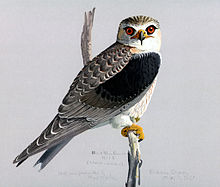Elanid kite
| Elanid kites | |
|---|---|
 |
|
| Elanus caeruleus | |
| Scientific classification | |
| Kingdom: | Animalia |
| Phylum: | Chordata |
| Class: | Aves |
| Order: | Accipitriformes |
| Family: | Accipitridae |
| Subfamily: | Elaninae |
| Genera | |
An elanid kite is any of several small, lightly-built raptors with long, pointed wings.
Some authorities list the group as a formal subfamily, Elaninae. As a subfamily there are six species in three genera with two of these genera being monotypic. Two other species have at times been included with the group, but genetic research has shown them to belong to different subfamilies.
Elanid kites have a near-worldwide distribution, with two endemic species found in the Americas, two in Australia, and one in Africa, while the black-winged kite is found over a vast range from Europe and Africa in the west to Southeast Asia in the east.
Elanus species are primarily rodent hunters, searching for prey from a perch or often hovering like kestrels. Their tail is unforked. Chelictinia feeds on the wing, taking insects from the air, or small reptiles and insects from tree branches. Its tail is very long and deeply forked, like Elanoides which has similar feeding habits but is larger.
Both Elanus and Chelictinia have similarities in markings, with red eyes, a black patch above the eye, yellow legs and cere, and black beak.
Gampsonyx is very small, also feeding on insects, with the size and coloration typical of the Asian falconets. It is black above and white below, often with a tinge of rufous around the legs.
In 1851 British zoologist Edward Blyth described Elaninae, the "smooth clawed kites", as a formal subfamily of Accipitridae. However they are also grouped in Accipitrinae, the broader subfamily of hawks and eagles described by French ornithologist Louis Jean Pierre Vieillot in 1816.
...
Wikipedia
